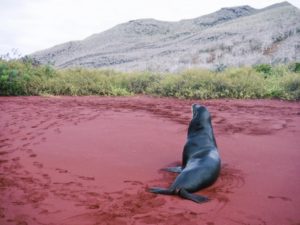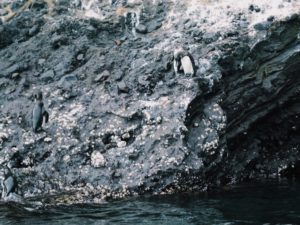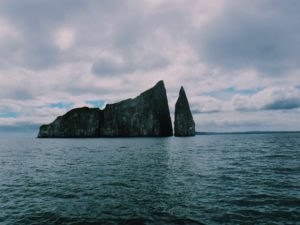Swimming with Sharks, Turtles, and Iguanas in the Galapagos
My last week in Ecuador was spent island-hopping in the Galapagos, a magnificently bio-diverse archipelago made famous partially by Charles Darwin’s On the Origin of Species. Before arriving on the islands, I knew little about the flora and fauna of the Galapagos beyond the varying finch populations and the principle of natural selection popularized by Darwin’s work. Upon boarding our one-hundred-passenger cruise ship, The Galapagos Legend, we were greeted by the enthusiastic crew. We moved into our surprisingly spacious cabins and explored the deck and lounge area before sitting down to a buffet lunch with a mix of Ecuadorian favorites and typical American-style foods.

Each day on the ship began with an early breakfast followed by a morning excursion, usually a guided walking tour of a new island, and continued with an afternoon activity of choice. Most guests elected to snorkel, and non-swimmers could view the marine life through a glass panel in the floor of a small boat that would jet around a shallow area. Although all the islands have similar origins and house similar species, each seems like its own distinct blend of life. For example, the sand on Rabida Island is a rich brick-red color, a stark contrast to the green-tinged lake twenty yards inland and the rolling hills dusted with frosty-white trees and prickly cacti.

The snorkeling was incredible. The standard rule in the Galapagos is for visitors to stay three meters away from all animals. Despite this rule, I had never felt so immersed in a natural habitat. The sea lions, somewhat lethargic on land, glide through the water so gracefully and quickly that my underwater camera only captured blurry images. On the first few snorkeling excursions, I occasionally saw a lone turtle, but on my third day, in Urbina Bay, there was a large crowd of them slowly circling each other. Each outing brought new surprises and new species; once, we swam next to penguins who would dive off the rocks and plunge headfirst below the water. On another occasion, I saw an iguana swimming, a slightly alarming sight after seeing hundreds of them living almost motionless in large groups on the islands, flicking their tails back and forth almost menacingly.

I would often abandon my snorkel in favor of diving deeper in order to swim next to a school of colorful fish or to glimpse what still remains of the coral reefs, ravaged by the changing temperatures brought by El Niño. There were soccer ball-sized purple sea urchins and sea stars in bright blues and reds. My favorite was probably the so-called chocolate-chip sea star, a faded yellow color dotted by black spots.
After four nights on The Legend, we departed on a boat for the island of San Cristóbal, where we spent two nights in a hotel. On our last full day we traveled by boat to Kicker Rock, the craggy remains of a volcanic cone towering above the ocean. As a snorkel group, we swam in between two adjacent walls in the deepest and coldest water we had tackled so far, but it was worth it when we encountered several one-meter long Galapagos sharks swimming in the open water below us. For some reason, I felt no fear being so close to them and knowing that hammerheads lurked beneath us. They seemed unbothered by our presence, and in the mind-numbingly cold water I felt almost tranquil.
